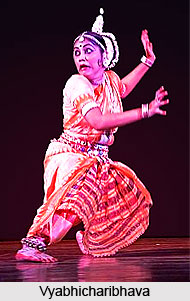 Abhinaya consists of the musical accompaniment which includes poetry, lyrical or narrative, which is set to music and rhythm. The vachikabhinaya of the Natya where the actors themselves use speech is replaced by the music accompanying the dance. In Nritta musical accompaniment utilizes svaras of a melody in a given rhythmic cycle. The poetry is interpreted by the dancers. The actual interpretation consists of portrayal of sancharibhavas of Sthayi bhava.
Abhinaya consists of the musical accompaniment which includes poetry, lyrical or narrative, which is set to music and rhythm. The vachikabhinaya of the Natya where the actors themselves use speech is replaced by the music accompanying the dance. In Nritta musical accompaniment utilizes svaras of a melody in a given rhythmic cycle. The poetry is interpreted by the dancers. The actual interpretation consists of portrayal of sancharibhavas of Sthayi bhava.
Poetry`s actual interpretation is done through a series of variations of the angikabhinaya. Here in each word of line of poetry is interpreted in many different ways as possible. The dancer gives a visual presentation of the theme of the poem which is sung. Here natyadharmi doctrine is followed as the dancer assumes different roles, without changing of dress or costume.
If the same actor assumes a different role in the same play then it is natyadharmi. If there is a play where graceful gesture dominates then it is natyadharmi. The whole sphere of dance belongs to the natyadharmi mode of presentation, where principle of "suggestion" guides the dancer. There is an artistic stylization which is implied when the whole range of impersonal human situations and experiences has to be expressed through gestures. This is seen in the depiction of those emotions which would ordinarily be the sphere of sattvikabhinaya. The three types of gesture seen in the abhinaya of the body in drama are of the sucha, sakha and ankura.  The sakha type of angikabhinaya belong to dance, as the theme is presented through the use of head, face, thighs, feet, hands, and so on. The most apt Vritta for the dance is the Kaiseki which is common to both Nritta and Nritya.
The sakha type of angikabhinaya belong to dance, as the theme is presented through the use of head, face, thighs, feet, hands, and so on. The most apt Vritta for the dance is the Kaiseki which is common to both Nritta and Nritya.
In the angas and upangas, abhinaya portion depends on the gesture of the hands and face, especially on the movements of the eyes, eyebrows and eyeballs. The movements of the head, chest and the thighs are also important. The movement of the feet is less significant in this portion. The feet movement is governed by the demands of the theme. The hands have been grouped under the categories of the single-hand gestures and double-hand gestures. Movement of the hand is the vehicle of an entire language of gesticulation. Hand movement is the focal point around which everything else revolves. All the primary hand gestures of both varieties can be used to convey ideas and emotions and symbols. The Universe, the seven spheres, the oceans, rivers, planets, human beings, and animals can be represented through hand-gesticulation. Movement of hands, eyes and eyeballs, are employed in samanyabhinaya and chitrabhinaya. Facial and head movements are important as the hasta in the abhinaya technique of the dance. The movement of the eye balls and eyebrows is related to its corresponding vyabhicharibhava, the Sthayi bhava and the rasa.
Complexity rules the technique of Indian classical dances. It builds from the smallest part into a composite whole through application of series of laws. This is done to evoke a particular stage of mind through Nritta or abhinaya. These basic techniques of Abhinaya are uniformly applicable to all styles of Indian classical dances. The movements vary and the fundamental postures are different and distinctive.




